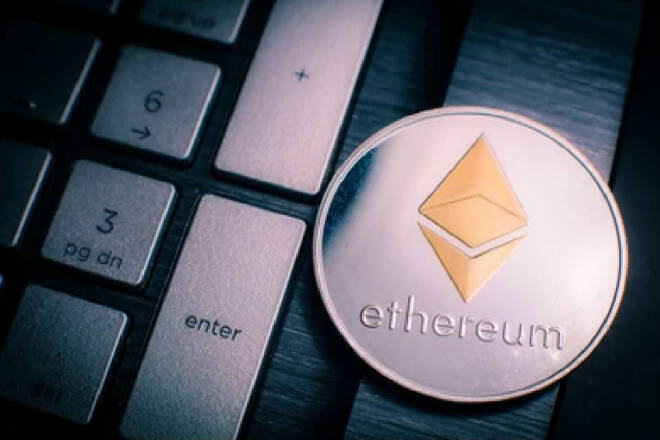Advertisement
Advertisement
ETH Withdrawal Profile and Staking Stats Support a Return to $2,000
By:
ETH bucked the broader market trend on Thursday, with staking inflows and a slide in principal withdrawals delivering bullish price signals.
Key Insights:
- It was a bullish Thursday session, with ETH rising by 0.41% to end the day at $1,943.
- Staking statistics offset bearish US economic indicators and fears of a US economic recession.
- However, the technical indicators remain bearish, signaling a return to sub-$1,900.
Ethereum (ETH) rose by 0.41% on Thursday. Partially reversing an 8.08% tumble from Wednesday, ETH ended the day at $1,943. Significantly, ETH fell short of the $2,000 handle for the first time since April 12.
After a choppy morning, ETH rose to a midday high of $1,983 before hitting reverse. Falling short of the First Major Resistance Level (R1) at $2,053, ETH fell to an early evening low of $1,914. However, steering clear of the First Major Support Level (S1) at $1,870, ETH found late support to wrap up the day in positive territory.
ETH Bucked the Broader Market Trend on Staking and Withdrawal Statistics
According to CryptoQuant, staking inflows rose from 74,528 ETH on Wednesday to 100,544 on Thursday. The surge came despite the global economic indicators and recessionary fears sending the broader crypto market into the red.
Total value staked figures also delivered bullish signals, rising through Thursday and this morning despite the Wednesday and Thursday crypto sell-off.
A marked shift in the projections for the ETH withdrawal profile added to the bullish sentiment.
According to TokenUnlocks, total pending withdrawals stood at 0.807 million ETH, equivalent to approximately $1.57 billion. Significantly, the withdrawal profile was bullish, with TotalUnlocks projecting modest ETH withdrawals throughout the Friday session.
On Thursday, a sharp increase in principal withdrawals weighed before the shift in the withdrawal profile, supporting the late ETH recovery.
The combination of the withdrawal projections, jump in staking inflows, and resulting upward trend in the total value staked are bullish price signals.
However, US economic indicators and recessionary fears pegged ETH back from more meaningful gains.
The Day Ahead
Investors should continue tracking ETH staking statistics and withdrawal profile actuals and projections. A jump in principal withdrawals and a downward trend in ETH staking inflows would be bearish.
Updates from the ongoing SEC v Ripple case and Binance and Coinbase (COIN)-related news will also need consideration.
However, US economic indicators and FOMC member commentary will influence the afternoon. The service sector and manufacturing PMI numbers will be in focus. Weaker-than-expected numbers would likely weigh on buyer appetite.
Ethereum Price Action
At the time of writing, ETH was down 0.03% to $1,943. A mixed start to the day saw ETH fall to an early low of $1,934 before rising to a high of $1,957.
ETH Technical Indicators
Resistance & Support Levels
| R1 – $ | 1,979 | S3 – $ | 1,910 |
| R2 – $ | 2,016 | S2 – $ | 1,878 |
| R3 – $ | 2,085 | S1 – $ | 1,809 |
ETH needs to move through the $1,947 pivot to target the First Major Resistance Level (R1) at $1,979 and the Thursday high of $1,983. A return to $1,950 would signal a breakout session. However, European and US economic indicators and staking statistics must support a breakout.
In the event of an extended rally, the bulls would likely test the Second Major Resistance Level (R2) at $2,016. The Third Major Resistance Level (R3) sits at $2,085.
Failure to move through the pivot would leave the First Major Support Level (S1) at $1,910 in play. However, barring another crypto market sell-off, ETH should avoid sub-$1,850. The Second Major Support Level (S2) at $1,878 should limit the downside. The Third Major Support Level (S3) sits at $1,809.
Looking at the EMAs and the 4-hourly candlestick chart (below), it was a bearish signal. Ethereum sat below the 100-day EMA, currently at $1,965. The 50-day EMA closed in on the 100-day EMA, with the 100-day EMA narrowing to the 200-day EMA, delivering bearish signals.
A move through the 100-day ($1,965) would support a breakout from R1 ($1,979) to give the bulls a run at the 50-day EMA ($2,007) and R2 ($2,016). However, failure to move through the 100-day EMA ($1,965) would leave S1 ($1,910) and the 200-day EMA ($1,886) in view. A move through the 50-day EMA would send a bullish signal.
About the Author
Bob Masonauthor
With over 28 years of experience in the financial industry, Bob has worked with various global rating agencies and multinational banks. Currently he is covering currencies, commodities, alternative asset classes and global equities, focusing mostly on European and Asian markets.
Advertisement
